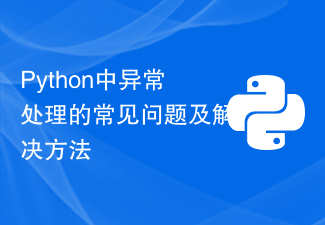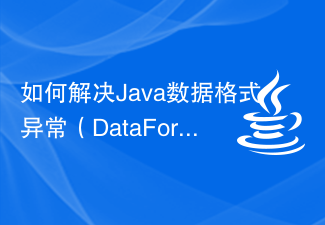How to solve code exception handling problems encountered in Java
Introduction:
In Java programming, we often encounter various exceptions. How to handle these exceptions correctly is a problem that every Java developer needs to master and solve. This article will introduce some common Java exception handling problems and solutions.
1. Understand the types and classifications of exceptions
Exceptions in Java can be divided into two categories: Checked Exception and Unchecked Exception. Checkable exceptions must be explicitly handled in the code, while uncheckable exceptions do not. When handling exceptions, we can use the try-catch statement to catch the exception and handle it accordingly.
2. Use the try-catch statement correctly
The try-catch statement is the basic mechanism for handling Java exceptions. In the try block, we write code that may throw an exception. In the catch block, we write the code to handle the exception. For example:
try {
// 可能引发异常的代码
} catch (Exception e) {
// 异常处理代码
}
It should be noted that the code in the catch block should be based on To handle the actual situation, you can output error messages, record logs, or take other appropriate measures.
3. Avoid using overly broad exception capture
When catching exceptions, we should try to avoid using overly broad exception types, such as Exception. Using an exception type that is too broad may result in incorrect handling of the exception type. Instead, exceptions should be caught using the most specific exception type, which allows for more accurate handling of exception conditions.
4. Use finally blocks for resource cleanup
Resource cleanup is an important part of Java exception handling. We can use finally blocks to ensure the correct release and closing of resources. The code in the finally block will be executed regardless of whether an exception occurs. For example:
try {
// 可能引发异常的代码
} catch (Exception e) {
// 异常处理代码
} finally {
// 资源清理代码
}
By using finally block, we can avoid resource leaks and the inability to release resources normally when exceptions occur.
5. Use custom exception classes
During the development process, sometimes we need to create custom exception classes to handle specific exception situations. By creating custom exception classes, we can better organize and manage exceptions and improve the readability and maintainability of our code.
6. Reasonable use of the throws keyword
Using the throws keyword in a method declaration can transfer the responsibility for exception handling to the caller of the method. Doing so increases the flexibility and reusability of your code. However, when using the throws keyword, we should pay attention to choosing the appropriate exception type so that the caller of the method can handle the exception correctly.
Conclusion:
By correctly handling exceptions in Java, we can improve the robustness and reliability of our code. In actual development, we should carefully analyze the code that may cause exceptions and handle exceptions reasonably. At the same time, we should also follow good coding practices and try to avoid abnormal situations. Through reasonable exception handling, we can ensure the correctness and stability of the code and improve the quality and user experience of Java applications.
Reference:
- Oracle official documentation, https://docs.oracle.com/javase/tutorial/essential/exceptions/index.html
- 《 Java Core Technology" (10th edition of the original book), edited by Cay S. Horstmann and Gary Cornell, Electronic Industry Press, 2012.
The above is the detailed content of How to solve code exception handling problems encountered in Java. For more information, please follow other related articles on the PHP Chinese website!
 C#技术开发中遇到的常见问题及解决方法Oct 08, 2023 pm 01:06 PM
C#技术开发中遇到的常见问题及解决方法Oct 08, 2023 pm 01:06 PMC#技术开发中遇到的常见问题及解决方法导语:C#是一种面向对象的高级编程语言,被广泛应用于Windows应用程序的开发。然而,在C#技术开发过程中,可能会遇到一些常见的问题。本文将介绍一些常见问题,并提供相应的解决方法,并且附上具体的代码示例,以帮助读者更好地理解和解决这些问题。一、NullReferenceException(空引用异常)在C#开发过程中,
 Python中异常处理的常见问题及解决方法Oct 09, 2023 am 08:56 AM
Python中异常处理的常见问题及解决方法Oct 09, 2023 am 08:56 AMPython中异常处理的常见问题及解决方法引言:在编写程序时,很难避免出现各种各样的错误和异常。异常处理是一种机制,可以在程序运行时捕获和处理这些异常,从而保证程序的稳定性和可靠性。在Python中,异常处理是一项非常重要的技能,本文将介绍Python中异常处理的常见问题和解决方法,并提供具体的代码示例。一、异常的分类及常见问题语法错误(SyntaxErr
 如何在PHP开发中处理异常和错误日志记录?Nov 02, 2023 am 09:27 AM
如何在PHP开发中处理异常和错误日志记录?Nov 02, 2023 am 09:27 AM如何在PHP开发中处理异常和错误日志记录?PHP作为一种非常流行的后端编程语言,广泛应用于Web开发领域。在开发过程中,我们经常需要处理异常和记录错误日志,以便及时发现和解决问题。本文将介绍如何在PHP开发中处理异常和错误日志记录的最佳实践。一、异常处理在PHP中,异常是一种用于处理错误情况的特殊对象。当代码遇到无法处理的错误时,我们可以抛出一个异常,并在合
 如何处理Java线程池满载异常Jun 30, 2023 am 10:09 AM
如何处理Java线程池满载异常Jun 30, 2023 am 10:09 AM在Java开发中,线程池是一种非常常用的多线程处理机制。它能够有效地管理、控制和复用线程,提高程序的性能和效率。然而,在实际开发中,线程池可能会遇到满载的情况,导致任务无法正常执行。本文将讨论如何处理线程池满载异常,以提高程序的稳定性和可靠性。首先,我们需要了解线程池满载异常的原因。线程池满载的主要原因是任务提交超过了线程池设置的最大线程数。当任务提交到线程
 C++中常见的数组越界问题解决方案Oct 08, 2023 pm 12:33 PM
C++中常见的数组越界问题解决方案Oct 08, 2023 pm 12:33 PMC++中常见的数组越界问题解决方案,需要具体代码示例在C++编程中,数组越界是一个常见的错误。当我们在访问数组中的元素时超出了数组的索引范围,就会导致程序出现未定义的行为。为了避免这类错误,我们需要采取一些解决方案。解决方案一:正确使用数组索引首先,我们需要明确数组的索引是从0开始的。例如,一个有5个元素的数组,索引范围是0到4。因此,在访问数组元素时,确保
 如何解决Java数据格式异常(DataFormatException)Aug 27, 2023 am 10:14 AM
如何解决Java数据格式异常(DataFormatException)Aug 27, 2023 am 10:14 AM如何解决Java数据格式异常(DataFormatException)在Java编程中,我们经常会遇到各种异常情况。其中,数据格式异常(DataFormatException)是一个常见但也很具挑战性的问题。当输入的数据无法满足指定的格式要求时,就会抛出这个异常。解决这个异常需要一定的技巧和经验。本文将详细介绍如何解决Java数据格式异常,并提供一些代码示例
 刨析Vue的服务器端通信策略:如何处理错误和异常Aug 11, 2023 am 09:12 AM
刨析Vue的服务器端通信策略:如何处理错误和异常Aug 11, 2023 am 09:12 AM刨析Vue的服务器端通信策略:如何处理错误和异常在开发Web应用程序时,与服务器进行通信是必不可少的一项任务。Vue.js作为一种流行的前端框架,提供了一套强大的工具和方法来处理与服务器端的通信。在这篇文章中,我们将重点探讨Vue的服务器端通信策略,并着重讨论如何在处理错误和异常时有效地利用这些策略。在Vue中,我们通常使用axios来处理服务器端通信。Ax
 PHP中如何处理数据库错误?Dec 17, 2023 am 10:23 AM
PHP中如何处理数据库错误?Dec 17, 2023 am 10:23 AMPHP中如何处理数据库错误?在开发PHP应用程序时,与数据库的交互是非常常见且重要的部分。然而,当涉及到数据库操作时,错误是无法避免的。为了应对这些错误并保证应用程序的健壮性和稳定性,我们需要正确地处理数据库错误。在本文中,我将向您介绍一些PHP中处理数据库错误的方法,并提供具体的代码示例。使用try-catch块捕获异常在PHP中,我们可以使用try-ca


Hot AI Tools

Undresser.AI Undress
AI-powered app for creating realistic nude photos

AI Clothes Remover
Online AI tool for removing clothes from photos.

Undress AI Tool
Undress images for free

Clothoff.io
AI clothes remover

AI Hentai Generator
Generate AI Hentai for free.

Hot Article

Hot Tools

SublimeText3 English version
Recommended: Win version, supports code prompts!

SAP NetWeaver Server Adapter for Eclipse
Integrate Eclipse with SAP NetWeaver application server.

WebStorm Mac version
Useful JavaScript development tools

SublimeText3 Linux new version
SublimeText3 Linux latest version

MinGW - Minimalist GNU for Windows
This project is in the process of being migrated to osdn.net/projects/mingw, you can continue to follow us there. MinGW: A native Windows port of the GNU Compiler Collection (GCC), freely distributable import libraries and header files for building native Windows applications; includes extensions to the MSVC runtime to support C99 functionality. All MinGW software can run on 64-bit Windows platforms.






